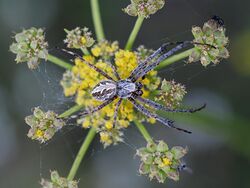Biology:Coneweb spider
| Coneweb spiders | |
|---|---|

| |
| Diguetia canities | |
| Scientific classification Error creating thumbnail: Unable to save thumbnail to destination
| |
| Domain: | Eukaryota |
| Kingdom: | Animalia |
| Phylum: | Arthropoda |
| Subphylum: | Chelicerata |
| Class: | Arachnida |
| Order: | Araneae |
| Infraorder: | Araneomorphae |
| Family: | Diguetidae F. O. Pickard-Cambridge, 1899 |
| Genera | |
| |
| Diversity | |
| 2 genera, 16 species | |

| |
Coneweb spiders (Diguetidae) are six-eyed haplogyne spiders that live in tangled space webs, fashioning a cone-like central retreat where they hide and lay eggs. It is a small family, containing only two genera split between a range in the Southwestern United States and Mexico and a range in South America.[1] Members of the genus Diguetia usually build their webs in shrubs or between cactus pads. They have the same eye arrangement as the venomous recluse spiders (family Sicariidae), but none are known to be harmful to humans.[citation needed]
Taxonomy
The group was first created by F. O. Pickard-Cambridge in 1899 as the subfamily Diguetiinae of the family Scytodidae.[1][2] It was raised to the rank of family by Willis J. Gertsch using the spelling "Diguetidae".[3] Pickard-Cambridge's use of double "i" is correct according to Article 29.3 of the International Code of Zoological Nomenclature,[4] since the name is based on the genus Diguetia. In 2004, Jörg Wonderlich suggested reducing it again to a subfamily, this time of Plectreuridae.[5] However, it is still sometimes considered a subfamily of the Plectreuridae.[1]
Genera and species
(As of April 2019), the World Spider Catalog accepts the following genera:[1]
Diguetia
Diguetia Simon, 1895
- Diguetia albolineata (O. Pickard-Cambridge, 1895) — USA, Mexico
- Diguetia andersoni Gertsch, 1958 — USA
- Diguetia canities (McCook, 1890) — USA, Mexico
- Diguetia canities dialectica Chamberlin, 1924 — Mexico
- Diguetia canities mulaiki Gertsch, 1958 — USA
- Diguetia catamarquensis (Mello-Leitão, 1941) — Argentina
- Diguetia imperiosa Gertsch & Mulaik, 1940 — USA, Mexico
- Diguetia mojavea Gertsch, 1958 — USA
- Diguetia propinqua (O. Pickard-Cambridge, 1896) — Mexico
- Diguetia signata Gertsch, 1958 — USA, Mexico
- Diguetia stridulans Chamberlin, 1924 — Mexico
Segestrioides
Segestrioides Keyserling, 1883
- Segestrioides badia (Simon, 1903) – Brazil
- Segestrioides bicolor Keyserling, 1883 (type species) – Peru
- Segestrioides copiapo Platnick, 1989 – Chile
- Segestrioides tofo Platnick, 1989 – Chile
See also
References
- ↑ 1.0 1.1 1.2 1.3 "Family: Diguetidae F. O. Pickard-Cambridge, 1899". Natural History Museum Bern. http://www.wsc.nmbe.ch/family/28.
- ↑ Pickard-Cambridge, F.O. (1899). "Subfam. Diguetiinae". in Godman, Frederick Ducane; Salvin, Osbert. Biologia Centrali-Americana: Arachnida - Araneida and Opiliones II. p. 53. https://www.biodiversitylibrary.org/page/575625. Retrieved 2016-05-13.
- ↑ Platnick, N.I. (1989). "A revision of the spider genus Segestrioides (Araneae, Diguetidae)". American Museum Novitates (2940): 1–9.
- ↑ ICZN (1999), "Art. 29.3", International Code of Zoological Nomenclature (4th ed.), London, UK: The International Trust for Zoological Nomenclature, http://www.nhm.ac.uk/hosted-sites/iczn/code/includes/page.jsp?article=29&nfv=#3, retrieved 2016-05-13
- ↑ Wunderlich, J. (2004). "Fossil spiders (Araneae) of the superfamily Dysderoidea in Baltic and Dominican amber, with revised family diagnoses". Beiträge zur Araneologie 3: 633–746.
Wikidata ☰ Q10054 entry
 |

